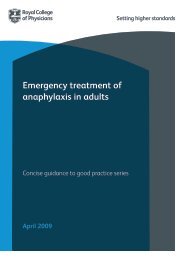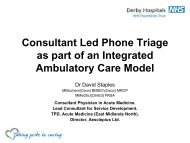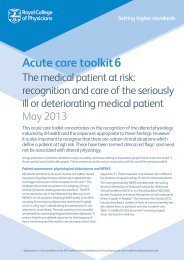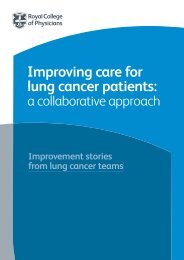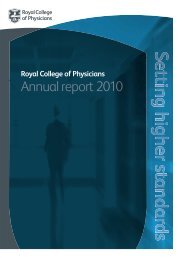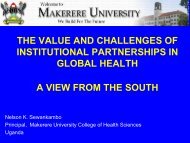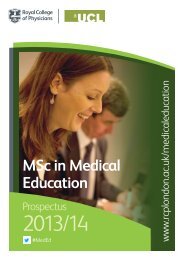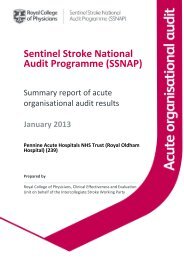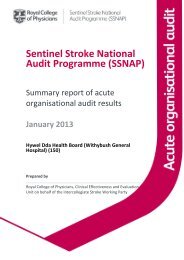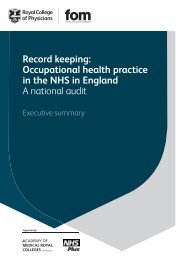Consultant physicians working with patients - Royal College of ...
Consultant physicians working with patients - Royal College of ...
Consultant physicians working with patients - Royal College of ...
You also want an ePaper? Increase the reach of your titles
YUMPU automatically turns print PDFs into web optimized ePapers that Google loves.
<strong>Consultant</strong> <strong>physicians</strong> <strong>working</strong> <strong>with</strong> <strong>patients</strong>As was outlined in the 2008 report published by theBSH and the RCPath, there are a number <strong>of</strong> pr<strong>of</strong>essionalissues that should be considered. 8 These include theincreasing complexity <strong>of</strong> treatment andsubspecialisation in haematology and other disciplines,the increasing impact <strong>of</strong> regulatory initiatives (egimproving outcome guidance and waiting-time targets)and legislation, as well as multidisciplinary <strong>working</strong> andinterhospital net<strong>working</strong>. Implementation <strong>of</strong> thedemands <strong>of</strong> Better blood transfusion: safe andappropriate use <strong>of</strong> blood 10 and the European directive onhaemovigilance 12 will require an additional 30–40consultants. An increasing laboratory workload (>5%increase per annum) generates increasing numbers <strong>of</strong>patient referrals and the need for clinical guidance onthe use <strong>of</strong> the laboratory and the interpretation <strong>of</strong>results. The specialty has supported improvements intraining programmes, but these too place greaterdemands on consultants’ and trainees’ time.The RCP report on the impact on medicine <strong>of</strong> theincreasing proportion <strong>of</strong> women entering the pr<strong>of</strong>essionidentified that haematology is one <strong>of</strong> the specialties thathas attracted a higher proportion <strong>of</strong> women. 17 As aresult, the current male:female ratio for consultantsover the age <strong>of</strong> 55 <strong>of</strong> 7:3 changes to 1:1 for youngerconsultants and for trainees it is 4:6. Since the male t<strong>of</strong>emale ratio <strong>of</strong> consultants that work less than full timein haematology is 1:4, an increasing number <strong>of</strong>consultant haematologists would be expected to workless than full time. In addition, the report also notedthat women who take career breaks are taking themlater in their medical careers as consultants, which isanother factor that will impact on the ability <strong>of</strong> aconsultant-delivered service to be maintained.Therefore, the pr<strong>of</strong>essional bodies recommend that thetotal number <strong>of</strong> consultant haematologists that will berequired is estimated to be 1250 (headcount).9 <strong>Consultant</strong> work programme/specimenjob planTable 4 outlines the typical work programme <strong>of</strong> aconsultant haematologist.10 Key points for commissioners1 Haematology is an integrated clinical and laboratoryspecialty; commissioning for one aspect <strong>of</strong> thespecialty <strong>with</strong>out consideration for the other mayimpact on the viability <strong>of</strong> a local service.2 Haematologists have a key role in providing adviceto other specialties <strong>with</strong>in a hospital as well as GPson both clinical and laboratory issues.3 Many aspects <strong>of</strong> a haematology service are nowprovided across a network that covers more than oneNHS provider and commissioners need to bear thisin mind when commissioning haematology services.4 Postgraduate training is closely linked to the currentorganisation <strong>of</strong> haematology services, another factorthat commissioners should bear in mind whencommissioning clinical and laboratory services.References1 Keele University. National Pathology Alliancebenchmarking review 2009–10. Keele: Keele University,2010.2 British Committee for Standards in Haematology.Facilities for the care <strong>of</strong> adult <strong>patients</strong> <strong>with</strong> haematologicalmalignancies – ‘levels <strong>of</strong> care’. BCSH Haemato-oncologyTask Force 2009. www.bcshguidelines.com/documents/levels<strong>of</strong>care 042010.pdf3 National Institute for Health and Care Excellence.Guidance on cancer services. Improving outcomes inhaematological cancers. The manual. London: NICE,2003.4 Fellows C. Analysis <strong>of</strong> frequent users, by local authority,April 2002–March 2003. London: London HealthObservatory, 2005. www.lho.org.uk/viewResource.aspx?id=97365 H<strong>of</strong>manD. Analysis <strong>of</strong> frequent hospital users, by PCT,April 2003–March 2004. London: London HealthObservatory, 2006. www.lho.org.uk/viewResource.aspx?id=102866 Department <strong>of</strong> Health. Updated national guidance on thesafe administration <strong>of</strong> intrathecal chemotherapy (HSC2008/001). London: DH, 2008.7 National Institute for Health and Care Excellence.Guidance on cancer services. Improving outcomes inchildren and young people <strong>with</strong> cancer. The manual.London: NICE, 2005.8 The British Society for Haematology and the <strong>Royal</strong><strong>College</strong> <strong>of</strong> Pathologists. Haematology consultantworkforce: the next 10 years. London: RCPath, 2008.9 Department <strong>of</strong> Health. The NHS cancer plan:aplanforinvestment,aplanforreform. London: DH, 2000.www.dh.gov.uk/en/Publicationsandstatistics/Publications/PublicationsPolicyAndGuidance/Browsable/DH 409813910 Department <strong>of</strong> Health. Better blood transfusion: safe andappropriate use <strong>of</strong> blood (HSC 2007/001). London: DH,2007.134 C○ <strong>Royal</strong> <strong>College</strong> <strong>of</strong> Physicians 2013



